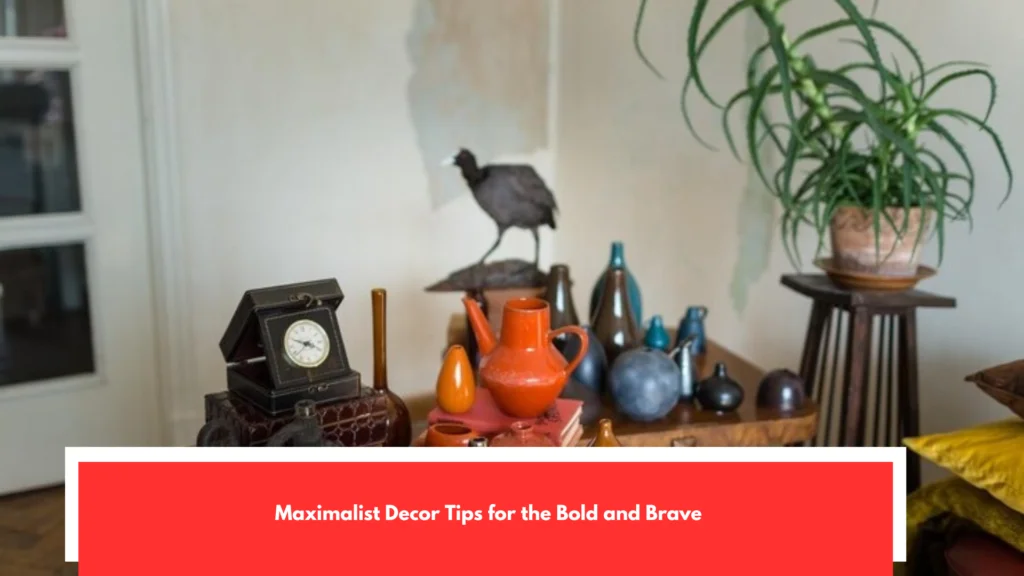Maximalist is seen as a lively reaction to minimalistic style, attacking heritage ideas of space, design, and aesthetics. This style is all about plenty, the combination of textures, patterns, the heavy use of color, and excessive ornamentation and provides an artistic solution where less is most certainly not more. The prospect of maximalism in architecture and interior design, then, consists in abandoning traditional rules, embracing detail, mixing freely, and playing with the extravagant—ideas echoed in Maximalist Decor Tips for the Bold and Brave.
Using the maximalist approach to your project implies filling the spaces with life, personality, and emotion so that no corner could remain without a certain story to be discovered in the composition and contrast of the style, materials, and decoration choices. As it is seen in the selection of the bright color palettes to the use of the elaborate furniture and every bold design pattern, this style orientation enables creating the opportunities of the unique environment design that would not be based on the conventions and should defy the expectations.
Differences between minimalism and maximalism

And now, in this post, we will tell you all that you have to know about the maximalism, how to incorporate it in your architectural and interior design project, and how to turn your spaces into the places of creativity, energy and style. Find out how to introduce this style to your projects and make memorable spaces. Minimalism and maximalism are contrasting types of design and decor Simplic of abundance. Minimalism aims at minimizing everything to the minimum level, maximalism is about the visual overabundance and richness of objects.
Color palette. Minimalism involves soft shades and neutral colors whereas maximalism involves bright and contrasting colors.
Space utilisation. Minimalism will create bare and neat spaces and the maximalism will create art, furniture and accessories in the environment. Texture and textures. The main emphasis of minimalism is on straight lines and smooth textures whereas maximalism involves placing art, furniture and accessories in spaces. Philosophy. Minimalism revolves around the theme of less is more and maximalism more is more. The ultimate goal of the maximalist style is to develop the interior full.
What the maximalist style seeks to convey

Of character, visual diversity and personalization. Free expanses of individual expression. It enables the occupants of an area to express themselves in a special manner, about who they are and what they like. Establish a bright and lively-skinned ambiance. The idea behind the combination of colors, patterns and textures is to have active and playful atmosphere where nothing is superfluous or dull. Each corner is a place to explore and find some new surprises. Violating the established design conventions.
Maximalism breaks the rules of simplicity and order. It wants to be extravagant and demonstrate that the more the better through variety and abundance of elements. Make intimate and personality spaces. Rather than having roomy and minimalistic rooms, the maximization concept is based on filling every corner with possible furniture as well as decorative items that make the surrounding experience very cozy and close to hearts. Collage of styles and epochs. Maximalism accepts variability in the architecture as it opened the possibility to mix the ancient and the newest design.
Characteristics of maximalist decoration

The classical and the modern one. This makes eclectic environments which may range so far as to comprise antique furniture to contemporary art works. Fete color and texture. In maximalism, colors are not shyness of colliding with other colors and textures are incorporated in order to give a lush feel to the touch. The maximalist style contributes to decorating styles with use of repeating patterns, bright colors and excessive furniture and ornaments.
In contrast to minimalism that gamble on the simplification of forms and streamlining of elements, maximalism is all about opulence, multiplicity of styles and infinite personal expression. Bright and contrast colors. Pattern and texture overlay. There is a combination of florals, geometrics and abstract designs along with velvet, marble and carved wood. Unusual amount of furniture and ornaments. Many pieces of decor.
Conclusion

The eclectic, homelike atmosphere is formed by pictures, sculptures, books, plants and personal mementos. Mish-mosh of styles, and eras. Old artifacts match with new artifacts, the baroque with the art deco or even a vintage piece of furniture and modern art. The rooms are a personality. Each corner displays some history and the preferences of the man who lives in the house which are not scared of the luxurious or the unnecessary. Strong and deep colors. Red, blue, green emerald, mustard yellow, purple and orange. Metallic colors. Golden, silver, copper and bronze, which bring luxury and glamour.
Dark colors. Just as black, charcoal gray, or navy blue that are integrates with lighter shades to make up the depth. Unexpected combinations. Maximalism is not afraid of combining the colors that do not usually go with each other such as pink and orange, green and purple, etc. to form dazzling and stunning contrasts. Patterns are essential to the introduction of dynamism and visual richness in spaces in maximalist style. Furthermore, it does not mind too much over my mixing and overlaying the patterns. Habitual trends of maximalism consist of: Floral.
